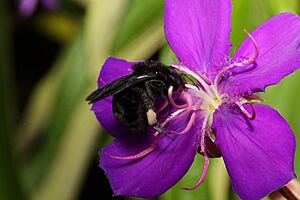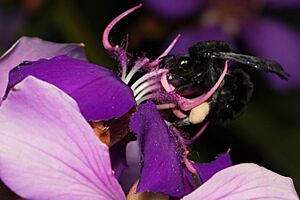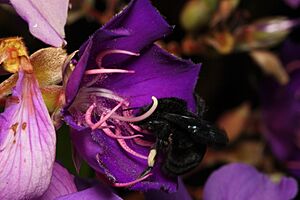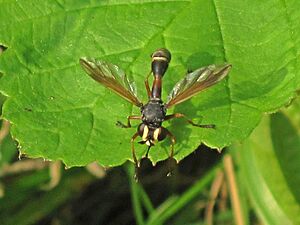Bombus morio facts for kids
Quick facts for kids Bombus morio |
|
|---|---|
 |
|
| Conservation status | |
| Scientific classification | |
| Genus: |
Bombus
|
| Species: |
morio
|
The Bombus morio is a special type of bumblebee. It is one of the few bumblebee species found in South America. These bees mostly live in the forests of Brazil. They often build their nests on the ground.
Bombus morio bees are among the largest bumblebee species. They are very important for helping plants grow. They do this by moving pollen from one flower to another. This is called pollination. They even use a special trick called buzz pollination to get pollen.
Contents
Meet the Bombus morio Bee
Most bumblebees live in colder places like North America and Europe. But the Bombus morio is different. It lives in the warmer parts of South America. Specifically, you can find them in the forests of Brazil. They like places with a mild climate.
These bees usually build their homes on the surface of the ground. Sometimes, they might also build nests underground.
How to Spot a Bombus morio Bee
The Bombus morio is a type of bumblebee. This means it shares some features with other bumblebees. Like all insects, they have three main body parts. These are the head, the middle part called the thorax, and the end part called the abdomen.
You can tell male and female bees apart by looking at their bodies. Female bees have 6 segments on their thorax. Male bees have 7 segments. Also, males have 12 segments on their antennae. Females have 13.
Female bees also have special pollen baskets. These are on their back legs. They are like little baskets with long hairs. Females use them to carry pollen back to their nest. Male bees do not have these pollen baskets.
Life in a Bombus morio Colony
We don't know everything about the Bombus morio colony cycle. But we do know some interesting facts. The life span of a worker bee is important. It tells us how fast a bee colony can grow.
For the Bombus morio, a worker bee lives for about 41 days. It takes about 32 days for a worker bee to grow from an egg to an adult. For male bees, it takes about 35 days. For queen bees, it also takes about 32 days. These times are a bit longer than for other bees. This means their colonies grow a little slower.
Bee-havior: Mating and Foraging
Mating Habits of Queens
Queen Bombus morio bees can lay eggs for a long time. Sometimes, a queen bee that has not mated can still lay eggs. This usually happens when she is about 40 days old. If a young queen stays in a colony with an older queen, she might act like a worker bee instead.
Queens do not need to mate to produce male bees.
Finding Food: Foraging
Bombus morio bees start looking for food a few days after they hatch. They fly to flowers to collect sweet nectar. They also collect pollen. When they land on a flower, their back is usually facing the center. This helps them collect pollen from the flower's stamens.
They are very good at moving pollen to other flowers. This makes them excellent pollinators. One visit from a Bombus morio bee can be enough for a flower to produce fruit. However, their large size means they cannot reach the nectar in very small flowers.
These bees mostly look for food in the morning. They collect most of their pollen between 6:00 AM and 8:00 AM. They can collect nectar until about 5:00 PM.
Buzz Pollination: A Special Trick
The Bombus morio bee uses a unique method to get pollen. It's called buzz pollination. The bee lands on a flower and holds the stamens with its legs. Then, it vibrates its body. This shaking helps to release the pollen from the flower. This makes them very effective at pollinating certain plants.
Building a Home: Nesting
Bombus morio bees build their nests in tropical areas. They usually build them on the surface of the ground. Like most bees, their nests are made mostly of wax. The area where the young bees grow is in the middle of the nest. This area holds the larvae of workers, queens, and males.
These bees are flexible about where they build their nests. They can also be quite aggressive. If a predator comes near their nest, they will try to sting it. They also spit out substances that can irritate attackers.
The Bombus morio Sting
The sting of the Bombus morio bee is known to be very strong. If a human is stung, it can cause a lot of pain. A reddish-orange spot might appear where the sting happened. Within a couple of hours, people might feel sick. They could have nausea, chills, and vomiting. They might also sweat a lot, feel dizzy, and have a headache.
Unwanted Guests: Parasites
Some tiny creatures can live inside Bombus morio bees. These are called parasites.
One type of parasite is the larvae of a tachinid fly. These larvae can be found inside the abdomen of female bees. The parasite does not stop the bee from flying. It also does not harm some of the bee's internal organs. However, it can completely damage the bee's ovaries. This means the bee cannot lay eggs.
Another parasite is a type of fly called Physocephala. Bees that have these parasites usually die within ten days. Like the tachinid fly larvae, the Physocephala larvae also live inside the bee's abdomen.





